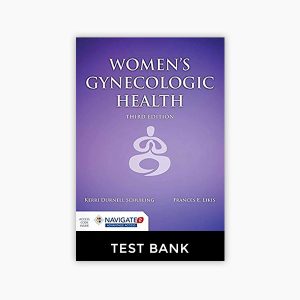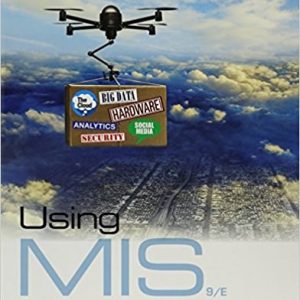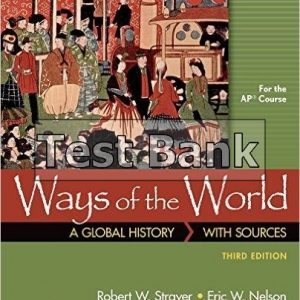This is completed downloadable of Test Bank for Horngren’s Accounting 11th canadian Volume 1 by Miller-Nobles

Product Details:
- ISBN-10 : 0134735331
- ISBN-13 : 978-0134735337
- Author: Miller-Nobles
Horngren’s Accounting presents the core content of the accounting course in a fresh format designed to help today’s learner succeed. The often difficult and intimidating topics in introductory accounting courses are reinforced with a wide variety of exercises and problems allowing students to practice similar questions many times until the concepts are clear.
Table of Content:
- 1: Accounting and the Business Environment
- Introduction: Accounting and the Business Environment
- Accounting: The Language of Business
- Accountants
- Forms of Business Organizations
- Accounting Concepts
- The Accounting Equation
- Accounting for Business Transactions
- The Financial Statements
- Review
- Summary Problem
- Key Terms
- Self-Study Questions
- Assignment Material
- Starters
- Exercises
- Problems (Group A)
- Problems (Group B)
- Critical Thinking
- Serial Exercise
- Challenge Exercises
- Beyond the Numbers
- Ethical Issue
- Fraud Case
- Challenge Problems
- Decision Problems
- Financial Statement Cases
- IFRS Mini-Case
- 2: Recording Business Transactions
- Introduction: Recording Business Transactions
- The Accounting Cycle
- Chart of Accounts
- Double-Entry Accounting
- Source Documents—The Origin of Transactions
- Recording Transactions in the Journal
- Posting (Transferring Information) from the Journal to the Ledger
- Accounting for Business Transactions
- Transaction 3: Purchase of Office Supplies on Account
- Transaction 5: Earning of Service Revenue on Account
- Transaction 9: Payment on Account
- T-Account Balances
- Posting to the Three-Column Ledger
- The Trial Balance
- Review
- Summary Problem
- Key Terms
- Self-Study Questions
- Assignment Material
- Starters
- Exercises
- Problems (Group A)
- Problems (Group B)
- Critical Thinking
- Serial Exercise
- Practice Set
- Challenge Exercises
- Beyond the Numbers
- Ethical Issue
- Fraud Case
- Challenge Problems
- Decision Problems
- Financial Statement Cases
- Communication Activity
- 3: Measuring Business Income: The Adjusting Process
- Introduction: Measuring Business Income: The Adjusting Progcess
- Time Period Assumption
- Recognition Criteria for Revenues and Expenses
- Accrual-Basis Accounting versus Cash-Basis Accounting
- Adjusting the Accounts
- Prepaids and Accruals
- Prepaid Expenses
- Amortization
- Unearned Revenues
- Accrued Expenses
- Accrued Revenues
- Summary of the Adjusting Process
- The Adjusted Trial Balance
- Preparing the Financial Statements from the Adjusted Trial Balance
- Chapter 3 Appendix: Alternative Treatment of Accounting for Prepaid Expenses and Unearned Revenues
- Review
- Summary Problem
- Key Terms
- Self-Study Questions
- Assignment Material
- Starters
- Exercises
- Problems (Group A)
- Problems (Group B)
- Critical Thinking
- Serial Exercise
- Practice Set
- Challenge Exercises
- Beyond the Numbers
- Ethical Issue
- Fraud Case
- Challenge Problems
- Decision Problems
- Financial Statement Cases
- Communication Activity
- 4: Completing the Accounting Cycle
- Introduction: Completing the Accounting Cycle
- The Accounting Cycle
- The Worksheet
- Working Through the Accounting Cycle
- Preparing the Adjusted Trial Balance
- Preparing the Financial Statements
- Closing the Accounts
- Post-Closing Trial Balance
- Correcting Journal Entries
- Classifying Assets and Liabilities
- Assets
- Liabilities
- The Classified Balance Sheet
- Accounting Ratios
- Debt Ratio
- Interpreting Ratios
- Chapter 4 Appendix: Reversing Entries: An Optional Step
- Review
- Summary Problem
- Key Terms
- Self-Study Questions
- Assignment Material
- Starters
- Exercises
- Problems (Group A)
- Problems (Group B)
- Critical Thinking
- Serial Exercise Part 1
- Serial Exercise Part 2
- Practice Set
- Challenge Exercises
- Ethical Issue
- Challenge Problems
- Decision Problems
- Financial Statement Cases
- IFRS Mini-Case
- Team Project
- 5: Merchandising Operations
- Introduction: Merchandising Operations
- What Are Merchandising Operations?
- Inventory Systems: Perpetual and Periodic
- Accounting for Inventory Purchases in the Perpetual Inventory System
- Purchase Returns and Allowances
- Transportation Costs: Who Pays?
- Selling Inventory and Recording Cost of Goods Sold
- Sales Discounts and Sales Returns and Allowances
- Adjusting and Closing the Accounts of a Merchandising Business
- Summary of Merchandising Cost Flows
- Preparing a Merchandiser’s Financial Statements
- Income Statement Formats
- Two Ratios for Decision Making
- Inventory Turnover
- Chapter 5 Appendix A: Accounting for Merchandise in a Periodic Inventory System
- Cost of Goods Sold
- Adjusting and Closing the Accounts in a Periodic Inventory System
- Journalizing the Closing Entries in the Periodic Inventory System
- Preparing the Financial Statements of a Merchandiser
- Summary Problem for Appendix A
- Chapter 5 Appendix B: Comparing the Perpetual and Periodic Inventory Systems
- Review
- Summary Problem
- Key Terms
- Self-Study Questions
- Assignment Material
- Starters
- Exercises
- Problems (Group A)
- Problems (Group B)
- Critical Thinking
- Serial Exercise Part 1
- Serial Exercise Part 2
- Practice Set
- Beyond the Numbers
- Ethical Issue
- Fraud Case
- Challenge Problems
- Decision Problems
- Financial Statement Cases
- IFRS Mini-Case
- Team Project
- 6: Accounting for Merchandise Inventory
- Introduction: Accounting for Merchandise Inventory
- Inventory Costing Methods
- Inventory Costing in a Perpetual System
- First-in, First-out Method
- Moving-Weighted-Average-Cost Method
- Comparing FIFO and Moving-Weighted-Average Cost
- Inventory Costing in a Periodic System
- Other Inventory Issues
- Lower-of-Cost-and-Net-Realizable-Value Rule
- Ethical Issues
- Estimating Ending Inventory
- Review
- Summary Problem
- Key Terms
- Self-Study Questions
- Assignment Material
- Starters
- Exercises
- Problems (Group A)
- Problems (Group B)
- Critical Thinking
- Serial Exercise
- Practice Set
- Challenge Exercises
- Beyond the Numbers
- Ethical Issue
- Challenge Problems
- Decision Problem
- Financial Statement Case
- 7: Accounting Information Systems
- Introduction: Accounting Information Systems
- Effective Accounting Information Systems
- Components of a Computerized Accounting Information System
- How Accounting Systems Work
- Processing Transactions
- Enterprise Resource Planning
- Special Journals
- The Sales Journal
- The Cash Receipts Journal
- The Purchases Journal
- The Cash Payments Journal
- The Role of the General Journal
- QuickBooks
- Chapter 7 Appendix: Special Journals and Sales Taxes
- Review
- Summary Problem
- Key Terms
- Self-Study Questions
- Assignment Material
- Starters
- Exercises
- Problems (Group A)
- Problems (Group B)
- Critical Thinking
- Serial Exercise
- Practice Set
- Challenge Exercises
- Beyond the Numbers
- Ethical Issue
- Fraud Case
- Challenge Problems
- Decision Problems
- Communication Activity
- Team Project
- Comprehensive Problem 1 (Chapters 1–7)
- Comprehensive Problem 2 (Chapters 1–7)
- 8: Internal Control and Cash
- Introduction: Internal Control and Cash
- Internal Control
- The Components of Internal Control
- Internal Control Procedures
- Internal Controls for Ecommerce
- The Bank Account as a Control Device
- The Bank Reconciliation
- Preparing the Bank Reconciliation
- Journalizing Transactions from the Reconciliation
- How Owners and Managers Use the Bank Reconciliation
- Internal Control over Cash Receipts
- Cash Short and Over
- Internal Control over Cash Payments
- Internal Control over Petty Cash
- Ethics and Accounting
- Review
- Summary Problem
- Key Terms
- Self-Study Questions
- Assignment Material
- Starters
- Exercises
- Problems (Group A)
- Problems (Group B)
- Critical Thinking
- Serial Exercise
- Practice Set
- Challenge Exercises
- Beyond the Numbers
- Ethical Issue
- Fraud Case
- Challenge Problems
- Decision Problem
- Financial Statement Cases
- Communication Activity
- 9: Receivables
- Introduction: Receivables
- Receivables: An Introduction
- Accounting for Uncollectible Accounts
- Estimating Uncollectibles
- Writing Off Uncollectible Accounts
- Recovery of Accounts Previously Written Off
- The Direct Write-off Method
- Exercising Internal Control over Accounts Receivable
- Other Payment Methods
- Accounting for Notes Receivable
- Computing Simple Interest on a Note
- Recording Notes Receivable
- Accruing Interest Revenue
- Using Accounting Information for Decision Making
- Chapter 9 Appendix: Discounting (Selling) a Note Receivable
- Review
- Summary Problem
- Key Terms
- Self-Study Questions
- Assignment Material
- Starters
- Exercises
- Problems (Group A)
- Problems (Group B)
- Critical Thinking
- Serial Exercise
- Practice Set
- Challenge Exercises
- Beyond the Numbers
- Fraud Case
- Challenge Problems
- Decision Problems
- Financial Statement Cases
- IFRS Mini-Case
- 10: Property, Plant, and Equipment; and Goodwill and Intangible Assets
- Introduction: Property, Plant, and Equipment; and Goodwill and Intangible Assets
- Measuring the Cost of PPE
- Lump-Sum Purchase of Assets
- Betterments versus Repairs
- Ethical Issues
- Amortization
- Straight-Line Method
- Comparing Amortization Methods
- Other Issues in Accounting for PPE
- Disposing of PPE
- Selling PPE
- Exchanging PPE
- Accounting for Natural Resources
- Intangible Assets and Goodwill
- Review
- Summary Problem
- Key Terms
- Self-Study Questions
- Assignment Material
- Starters
- Exercises
- Problems (Group A)
- Problems (Group B)
- Critical Thinking
- Serial Exercise
- Challenge Exercise
- Beyond the Numbers
- Ethical Issue
- Fraud Case
- Challenge Problems
- Decision Problem
- Financial Statement Cases
- IFRS Mini-Case
- Communication Activity
- Appendix A: Chart of Accounts for Proprietorship
- Glossary
- Credits
- Acronyms for Volume 1





